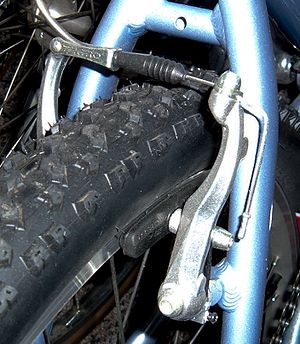Brake
A brake is a device for slowing or stopping a moving machine part.[1] The most common brakes are for wheels, such as those on cars and bicycles.

The kinetic energy lost by the moving part is usually converted into heat by friction. There are also regenerative braking systems that store some of the energy in a flywheel or capacitor, or convert it to electricity to store in a battery or send to some other machine. The first braking systems were used on horse-drawn vehicles. The horse accelerated the cart to relatively high speeds and could not cope with its stopping by itself. The first mechanisms braked the wheel itself by means of a manual lever or a system of levers.
The first braking systems were used on horse-drawn vehicles. The horse accelerated the cart to high speeds and could not cope with its stopping by itself. The brake used a manual lever or a system of levers to press a wooden block onto the wheel, slowing it by friction. In wet weather, it was ineffective. Later, faster vehicles such as bicycles, trains and automobiles needed much better brakes, and many kinds were invented. Even some airplanes have brakes to slow them in the air.
Related pages
changeReferences
change- ↑ Factum, part 3, page 123, Finnish ISBN 9513566420 003 1 398